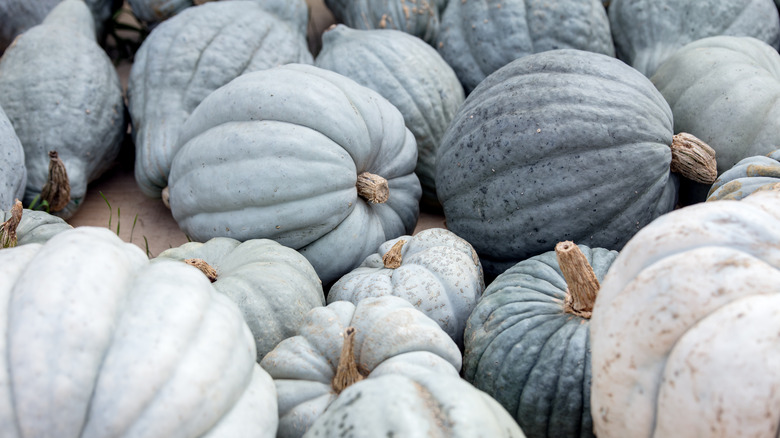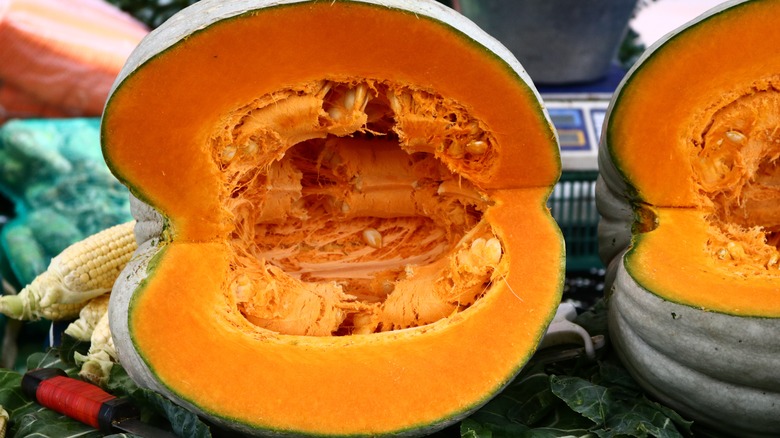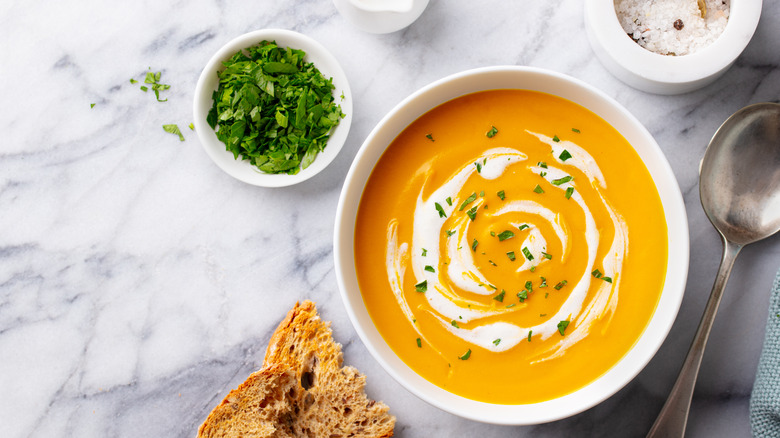What Makes Hungarian Blue Pumpkins Unique?
If you have ever meandered the stalls of a farmer's market and spotted what appears to be a pumpkin, but instead of its usual classic orange color, the skin appears to be a strange, ethereal, and almost eerie light grey-blue, your eyes haven't deceived you. The grey pumpkin has not been painted for a Tim Burton film or manipulated for decorative purposes, but is actually a variety of squash or pumpkin called the Hungarian blue pumpkin.
According to Graines de Vie, this variety was discovered in Budapest by agriculturist Philippe Desbrosses in 1983, and given the name Hungarian blue pumpkin due to its unique pale blue-grey color. However, the inside of the pumpkin reveals a flesh similar to the more traditional orange pumpkins: orange-yellow. It's a delicious and atypical variety of pumpkin that is not only unique looking but also very sweet, dense, and versatile, to be used in a variety of recipes both sweet and savory.
Where to find the Hungarian blue pumpkin
The Hungarian blue pumpkin variety can be found in its natural habitat of Hungary, where the Hungarian name for the runner squash is "nagydobosy sütökok." To grow your own Hungarian blue pumpkins, you'll need well-loosened and rich soil and to plant seeds 2 cm deep, but they can also be grown in a container (per Fulmina Foods), and once harvested they can be used in gratins, pies, soups, and other dishes. Another bonus: the Hungarian blue pumpkin conserves well, so you can have a stock that will last throughout a long winter.
Heirloom seeds for this special pale grey-blue pumpkin variety are available for purchase online, and are to be sown in spring, as they require a healthy amount of sun. Another similar variety of pumpkin is called the Jarrahdale pumpkin, which originates from Western Australia and also boasts a beautiful blue color and sweet, orange-yellow interior (per Home for the Harvest).
How to cook with the Hungarian blue pumpkin
The orange-yellow and dense flesh of the Hungarian blue pumpkin is sweet and rich, according to Cuisine à l'Ouest. As the Hungarian blue pumpkin is quite hard and dense, you'll need a sharp and strong knife to cut through the tough flesh. The best way to cut it is to first slice it in half, and then into slices. The work is well worth the payoff, however, since the density leads to a lot of flesh to cook or bake with. If you prefer, you can then remove the outer layer, but the skin is edible (as long as the pumpkin isn't too old), as are the copious amount of seeds. To avoid any food waste, you can take the big seeds and grill them to enjoy later as an appetizer or snack.
With the sweet flesh of the Hungarian blue pumpkin, you can then make a variety of purees, soups, or even substitute this atypical variety into desserts that use squash or sweet potato.
Recipes for a Hungarian blue pumpkin
After you've cut your Hungarian blue pumpkin into slices, you can cut them into cubes and then steam them to start a purée base, or simply roast them directly alongside other vegetables like carrots, potatoes, or turnips, all drizzled with olive oil.
Cuisine AZ recommends this vegan recipe, which highlights the unique taste of the Hungarian blue pumpkin. After it's washed, cut the pumpkin into two halves and then hollow the center out. Next, coat the flesh in a layer of olive oil with a brush and then bake at 180 degrees Celsius (that's about 356 degrees Fahrenheit) for around 40 minutes. While the pumpkin is baking, prepare the stuffing: take 250 grams of firm tofu, two cloves of garlic, a small grated carrot, a dozen pitted black olives, some cilantro, and a few basil leaves and mix in a food processor until you get a crumbly filling. Add a few tablespoons of olive oil and then blend again. After the pumpkin is baked halfway through, take it out, add the stuffing, and then bake for the remaining 20 minutes. It's recommended to be served with a basil and gomasio emulsion.



